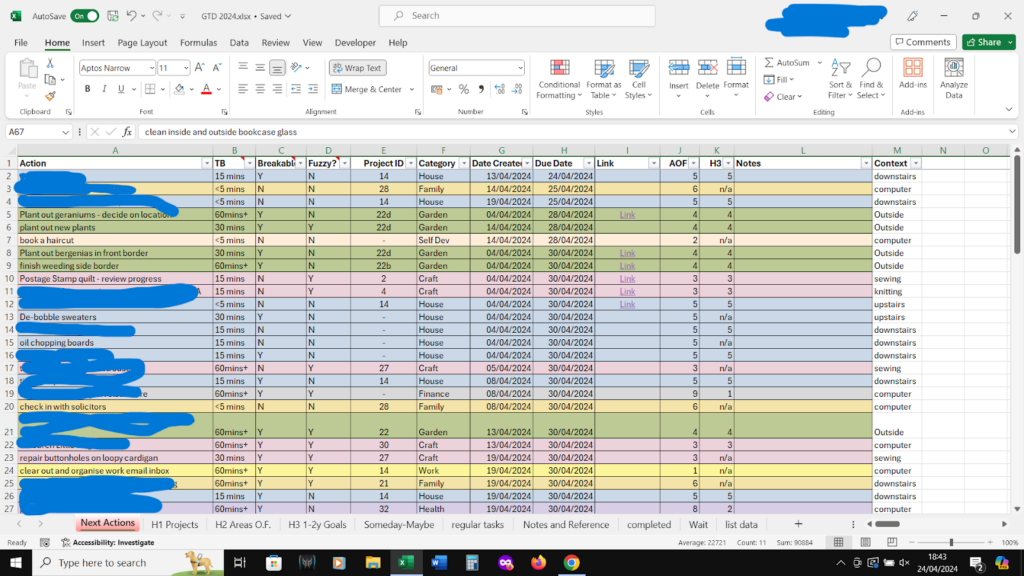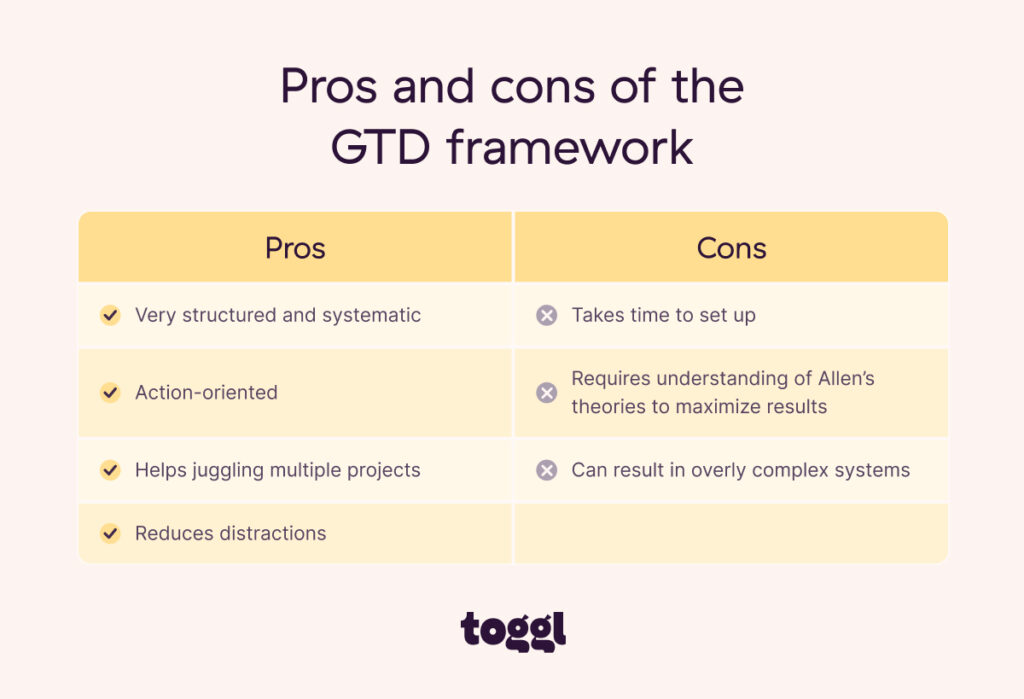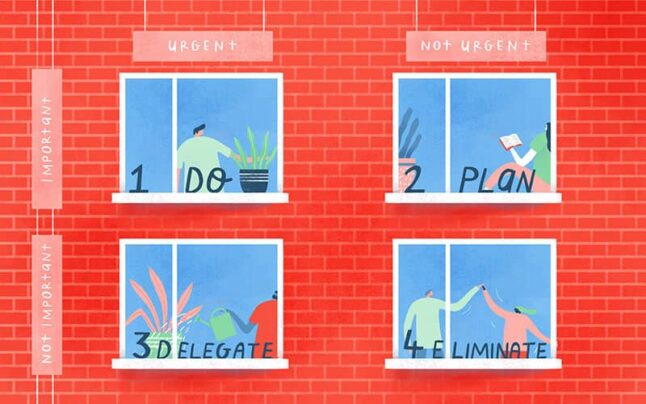This deep dive is part of our “Productivity Pr0n in Practice” series, where we examine some of the leading go-to productivity hacks, the theory behind them, and try to establish whether they actually work in real life!
American radio shock jock Howard Stern is the last person I expected to hear talking about productivity hacks. But in the Summer of 2012, he seemed almost obsessed with a new productivity method he was using, telling his daily audience of 10 million viewers he had never felt more organized in his entire life.
“I have zero emails in my inbox. I am so organized and getting through all my tasks. It is the greatest feeling ever.”
Stern wasn’t the only one on (productivity) cloud-nine after discovering David Allen’s Getting Things Done® (GTD) framework. He wasn’t alone—GTD’s promise of unlocking creative flow and improving cognitive function has attracted everyone from Oprah Winfrey to Will Smith.
Fast-forward to today, and the productivity framework is still talked about and even has its own fans on Reddit.
Still, I was skeptical. Allen first talked about the system in a book he published in 2001, and a lot has changed since then. I wanted to see if a system created before the iPhone or TikTok even had a place in modern productivity discussions.
Here’s what I found out 👇
Wait—What is GTD?
Getting Things Done® is a productivity system that focuses on freeing up your mind, creating structured to-do lists and attaching time limits to tasks.
The goal of GTD is to create space in your brain to focus on tasks and eliminate distraction using a 5-step process:
✍️Capture. This is where you put together your core list. Think about anything down that is “pulling on your psyche” or tasks you need to get done. Write them down, either on a piece of paper or in a digital format like a spreadsheet. This could include anything from a pressing work task to buying a birthday present. If it’s on your mind—put it on the list.
🔍Clarify. Next, go through each item on your list and decide if they are actionable. If something is not actionable (e.g., a receipt you can’t expense), either archive it or bin it—then move on. However, if it can be done in two minutes—do it then and there. If the action item will take longer, either delegate it to someone else or defer it to a future date.
🗄️Organize. Put your tasks into lists and group them together based on project, context or deadline.
🤔Reflect. Then, review your projects to ensure each task has a purpose and is progressing. Allen recommends reviewing your list weekly.
🤓Engage. Finally—start working on the tasks. At this point of the process, instead of wondering about what task to do first, the system will clearly outline tasks by project, deadline and time estimate. This will help you choose the right task and stay focused.

What’s interesting about GTD is the actual work doesn’t start until the last step of the process. But as Allen says, Getting Things Done isn’t about getting things done—it’s about being engaged with what’s going on.
But… does the process work? And does the amount of prep work outweigh the positives? 🤔
We created a cheat sheet to help productivity-seekers like you get to grips with GTD 🤓
The Pros and Cons of the GTD method
The beauty of GTD is in the brain dump.
Organizing all of the tasks floating around your head into a system frees up psychological space to focus. Allen says this helps separate the tasks from your psyche and keeps you “appropriately engaged” when you start working on them.
While GTD can clear your mind, it can also take a lot of time to set up and requires a solid understanding of how to categorize tasks correctly.
So while GTD is—on paper—a spreadsheet-lover’s dream, how does it stack up in the real world? 🤔
Why GTD makes sense on paper (but sometimes not in practice)
The “front-end planning” approach of GTD is what attracts most people to it.
Every task has a category and a deadline. The planning is so extensive that there are lists for everything from urgent work to “someday maybe” tasks. Some people will love this level of organization and thrive on writing every single idea and task down into a spreadsheet. Others will find this sheer volume of tasks on a spreadsheet overwhelming.
But, GTD is also… how do I put it? Vintage.
Allen created GTD before X or Instagram existed, and well before we launched Toggl Track. In 2005, when Wired labeled GTD the “new cult for the info age”, it also talked about tools like del.icio.us and Flickr (remember those?). It was also clear users freakin’ loved GTD:
“The problems of overload and attention deficit that seem to be spreading so rapidly these days have been staples in the geek world since time immemorial. I wouldn’t say I was disorganized so much as just overwhelmed (by) the constant e-mails and disruptions. GTD has improved the quality of my work, if for no other reason than it’s helped me get much better at saying ‘no.'”
I wonder what these same users would say today, considering we have way more distractions in our personal and work lives. The reality is, GTD was created for a different time. Just listen to how Allen talked about it to Wired:
“Because GTD is system-neutral, it also gives geeks a great model for plugging in their favorite mobile toys. But GTD relates equally to paper or any other medium.”
Mobile toys? 😆
Yikes. Moving on.
Just because GTD is nearly 25 years old doesn’t mean it won’t work. What it does mean is we have a bunch of new software and productivity tools available to help us be more organized in our daily lives. In my opinion, there are better ways to use GTD so it’s less labor intensive, as it’s easy to get carried away with the pre-planning involved.
I mean, just check out this spreadsheet from a GTD user on Reddit:

I’m not trying to hate. But did “book a haircut” really need to be added to the spreadsheet and given a category, due date and time limit?
It would have been quicker to just… ring up and book the damn haircut 🙃
Like a lot of the other productivity methods we have tested in this Deep Dive series, I think the best way to maximize GTD is to take the best bits and tweak it to suit your own needs. Here’s an example of how I did just that 👇
Stealing the nuts + bolts of GTD to build a simpler system
At this point, I decided to steal the best bits of GTD and build a simpler system. One that didn’t look like that Redditor’s spreadsheet.

There were three caveats I figured out pretty early:
- GTD isn’t for every professional. For entrepreneurs, business owners or anyone in control of their own schedule, GTD will probably be a great fit. But for people who have little control over their workday, GTD will be (nearly) impossible to use. Just imagine trying to organize a brain dump when a manager is throwing random tasks at you. It just wouldn’t work.
- GTD doesn’t account for personal distractions. You can’t schedule everything. For example, domestic distractions, like looking after a sick child, will prevent you from accessing Allen’s “stress-free state of flow”. But there’s also no avoiding this because… life. In this sense, the system is very rigid—maybe too rigid unless you have a predictable schedule.
- GTD isn’t a quick productivity hack. Allen admits it takes about two years for someone to really master the GTD system, so it requires you to jump in both feet first.
However, I think GTD can still be useful if it’s simplified:
✍️Capture. Write down your core list, but don’t go OTT. Be mindful about what tasks you want to put into a spreadsheet and be realistic about why you want to do them. I’ve seen some GTD folks online put tasks like “water garden” or “feed pets” on their list. Is it really necessary to put these tasks onto a GTD spreadsheet? It’s a waste of time typing them out and attaching a deadline when you would be doing them anyway.
🔍Clarify. I question why tasks have three options (actionable, archive or delete). If a task wasn’t actionable, I archived it instead of deleting it. I think having two options is confusing, and realistically… How often will you be looking into archived tasks anyway? Keep it simple. Actionable or archive, then move on.
🗄️Organize. I would also cut one option out of this step of the process. Instead of delegating, scheduling or saving a task, I would instead just delegate or save an item. I would save the task scheduling and do it during the weekly review to save time.
🤔Reflect. The weekly review is when I would archive any tasks I didn’t think would make an impact on my life to free up space. I would also plan my week out at this point so I had a realistic idea of my capacity for any more tasks.
🤓Engage. This step of the process—where the work happens—obviously stays!
On top of these tweaks, I would add two elements to make the system more impactful:
⏰Use time tracking. Allen’s system is missing a fourth dimension: time tracking. Properly managing your time can help you gain a sense of control over your life, but it also helped me understand how realistic the deadlines in my system were. For example, I used time blocking for some of the tasks and activities on my GTD list. As I already knew (roughly) how long each task would take using GTD pre-planning, this made time blocking easy and ensured I scheduled to my capacity.
🧘Schedule self-care/social stuff. Add self-care practices to your daily schedule, whether it’s meeting up with a friend or doing some exercise. These are non-negotiable “tasks.” You’re not an island, and a productivity system isn’t enough to eliminate stress if you don’t take care of yourself.
Without some degree of self-awareness, you’ll otherwise spend most of your time chasing tasks your brain deems urgent, such as responding to emails, but not those that move you toward realizing bigger goals.
Ready to make GTD work for you?
The beauty of GTD is that nobody is stopping you from hacking it to suit your own needs and applying it to your life in your own unique ways. You may choose only to embrace Allen’s system fully when you’re going through a pretty hectic period of your life and feel overwhelmed by too many tasks.
There’s also no reason you can’t pause using this system when you’re working on big creative projects for an extended duration of time.
Whatever you choose, GTD can be an invaluable tool to help you finish what you start.
As Allen says—Complete the projects you begin, fulfill the commitments you have made, live up to your promises. Then both your subconscious and conscious selves can have success, which leads to a feeling of fulfillment, worthiness and oneness.
We created a cheat sheet to help productivity-seekers like you get to grips with GTD. Grab your free copy here 📋



